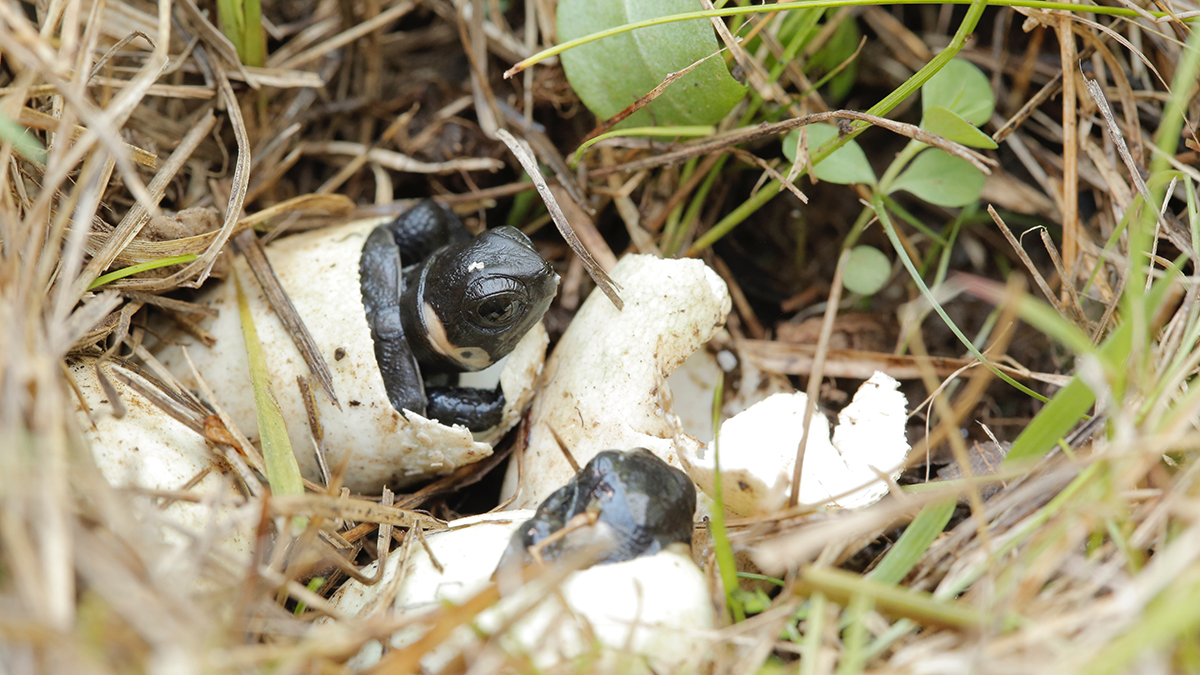By Molly Kirk/DWR
J.D. Kleopfer, state herpetologist for the Virginia Department of Wildlife Resources (DWR), calls bog turtles “little tanks on the landscape.” North America’s smallest turtle species, the bog turtle (Glyptemys muhlenbergii) grows to only about four inches in shell length. And while they’re small, they’re not afraid to travel, hence the tank reference. “We had one turtle we were tracking travel five miles across a landscape filled with roads and fences. They’re just wandering around, trying to make their way from one wetland to the next,” said Kleopfer.

Juvenile bog turtle. Photo by USFWS
Bog turtles can be found in Virginia only in the southern Blue Ridge Plateau (Carroll, Floyd, Grayson, Franklin, Patrick, and Roanoke counties) in wet meadows. They’re semi-aquatic in their shallow wetland habitats, splitting their time between being in small, muddy rivulets and being on land or on top of hummocky vegetation in these wetlands. Their ideal habitat is sedge bogs and fens with limited tree canopy cover. They primarily eat insects, slugs, earthworms, and aquatic invertebrates.

A bog turtle. Photo by J.D. Kleopfer/DWR
There are two distinct population segments of bog turtles in the United States—the northern (found in Connecticut, Delaware, Maryland, Massachusetts, New Jersey, New York, and Pennsylvania) and the southern (found in Georgia, North Carolina, South Carolina, Tennessee, and Virginia). The northern population is federally listed as threatened under the Endangered Species Act, added to the list in 1996 after significant population declines.
The southern population, including those in Virginia, aren’t technically listed under the ESA, but are listed as “threatened by similarity of appearance” to the northern bog turtle population. Nonetheless, DWR has been doing population surveys and habitat work for the species for decades, hoping to help keep the southern population from being added to the Endangered Species list. In 1987, the species was added to the Virginia Endangered Species list.
“One of the big challenges is that they’re what we refer to as a meta-population species. They don’t just occur in one site; they bounce around a bit,” Kleopfer said. “We do have some sites where we know there are a lot of turtles, but it’s a patchwork of little habitats. It’s like someone took a pepper shaker and shook them all out over the landscape. They can occupy wetlands as small as 4/10 of an acre. But a lot of their habitat has been drained for agricultural use or converted to farm ponds. It’s challenging to protect the habitat because it is scattered around the landscape, and most of it occurs on private land, so working with private landowners is very critical in their conservation.”

Bog turtles hatching. Photo by Mike Knoerr
Habitat loss, combined with road mortality and poaching for the pet trade, has had significant impacts to bog turtle populations. “It’s definitely a natural history legacy for Virginia to keep bog turtles on the landscape,” said Kleopfer. “They were heavily poached in the ‘80s and into the ‘90s for the pet trade. There is some evidence that some is still going on. That’s why we try and keep the location of their sites a secret.”
DWR works with partners, including National Park Service, Virginia Tech, Natural Resources Conservation Service, the Virginia Department of Conservation and Recreation (DCR)-Natural Heritage and nongovernmental organizations in efforts to maintain a network of ecologically viable bog turtle populations throughout the species’ range in Virginia and to avoid the need for federal listing within the Commonwealth. Those efforts include continuing population surveys, habitat protection and restoration, outreach and education for communities and landowners on habitat conservation and awareness about poaching for the illegal pet trade.


